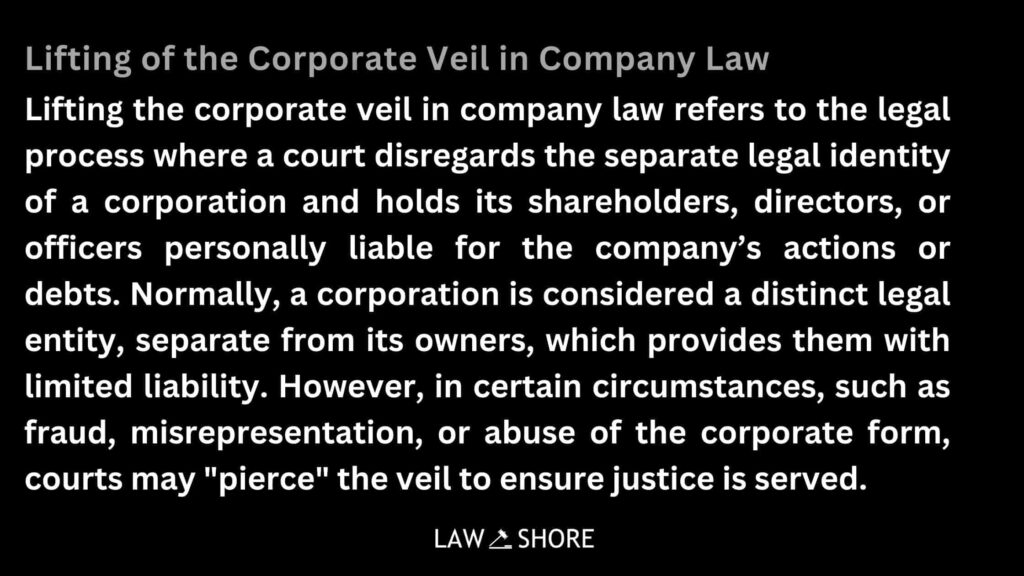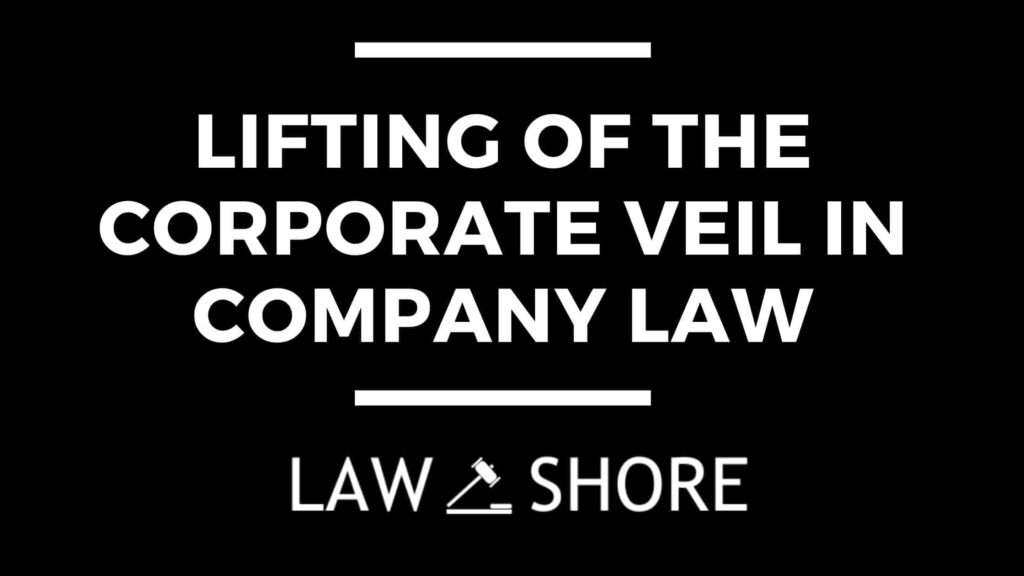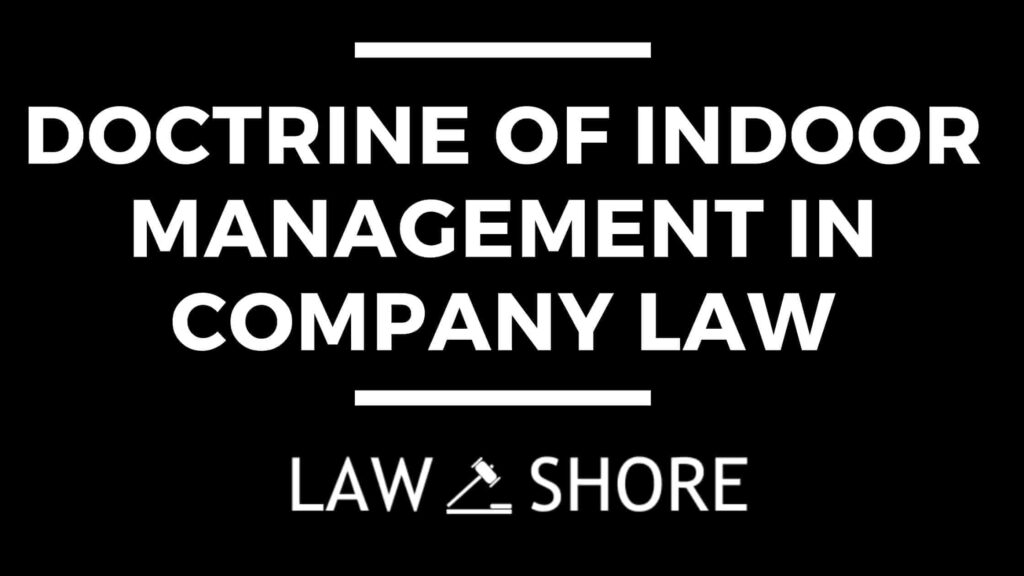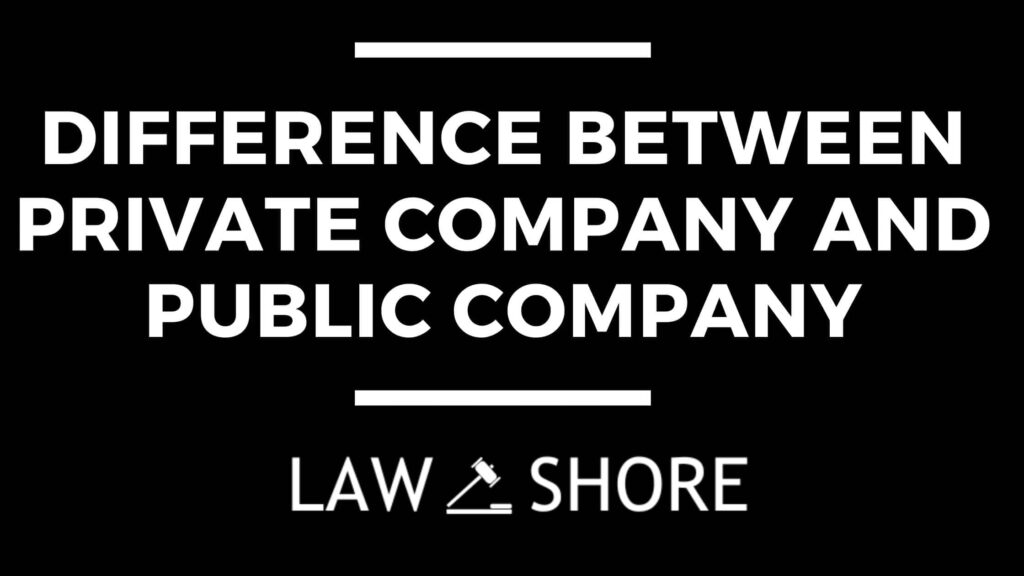Lifting the Corporate Veil in Company Law
Table of Contents
ToggleLifting the corporate veil in company law refers to the legal process where a court disregards the separate legal identity of a corporation and holds its shareholders, directors, or officers personally liable for the company’s actions or debts. Normally, a corporation is considered a distinct legal entity, separate from its owners, which provides them with limited liability. However, in certain circumstances, such as fraud, misrepresentation, or abuse of the corporate form, courts may “pierce” the veil to ensure justice is served.
Lifting the corporate veil typically occurs when the corporation is used as a shield for wrongful conduct—for example, to evade debts, commit fraud, or bypass legal obligations. Courts may hold individuals personally liable if the company is found to be a mere facade or alter ego of the individuals controlling it. This principle is a safeguard to prevent unfair outcomes and ensure that corporate structures cannot be used to perpetuate injustice. Ultimately, it aims to balance the benefits of limited liability with the need to protect third parties and uphold fairness.

Origin of Lifting the Corporate Veil in Company Law
The origin of lifting the corporate veil traces back to the principle of separate legal personality, which was firmly established in the landmark case of Salomon v. Salomon & Co. Ltd. (1897). In this case, the House of Lords ruled that a corporation is a separate legal entity distinct from its shareholders, granting them limited liability and protecting them from personal responsibility for the company’s debts.
However, over time, courts recognized that this protection could be misused to evade legal obligations, commit fraud, or avoid justice. The need to pierce the corporate veil emerged as a judicial response to prevent such misuse. Early cases, such as Gilford Motor Co. Ltd. v. Horne (1933) and Jones v. Lipman (1962), began to establish the doctrine that courts could lift the veil in instances where the corporate structure was used for fraudulent or unjust purposes.
Thus, while Salomon set the foundation for the corporate shield, subsequent judicial decisions recognized that in certain circumstances, the veil could be lifted to hold individuals accountable for wrongful acts committed through the corporate form. This developed into a legal tool to prevent fraud, injustice, and abuse of the corporate entity.
Elements Required for Lifting the Corporate Veil in Company Law
The elements required for lifting the corporate veil generally depend on the facts of each case, but there are several common legal grounds on which courts base their decision. These elements are typically seen in cases of fraud, misconduct, or to prevent injustice. Here are the main elements that may justify the lifting of the corporate veil:
Fraud or Misrepresentation
- Intentional Fraud: If the corporation is being used as a vehicle for committing fraud, evading legal obligations, or misleading creditors, the courts may lift the veil to hold the individuals accountable.
- Deception of Creditors: If the corporate structure is used to deceive creditors or avoid legal obligations (e.g., by transferring assets out of reach), the veil can be lifted.
Improper Use of the Corporate Entity
- Sham or Façade: If the company is used merely as a facade or shell to conceal the true facts or to avoid obligations, courts can pierce the veil. For instance, when a company is created solely to carry out a fraudulent scheme.
- Lack of Corporate Formalities: In cases where the corporation is not operating as a distinct entity, with no distinction between personal and corporate assets or responsibilities, courts may disregard the entity’s status.Control and Abuse of the Corporate Form
- Alter Ego Doctrine: If the corporation is effectively controlled by an individual (or a small group of individuals), to the point that it has no independent existence or is a mere “alter ego” of the controlling party, courts may disregard its separate existence. The individual(s) may be personally liable.
- Domination and Control: Where the individual or a group exercises complete control over the corporation and uses it for personal benefit, particularly if the corporation’s assets are used for personal gain, the corporate veil may be lifted.
Avoidance of Legal Obligations
- If the corporate structure is being used to avoid statutory obligations (e.g., tax liabilities, regulatory duties), courts may lift the veil. For example, using a corporation to avoid liability for debts or illegal activities might prompt the court to intervene.
Public Policy Considerations
- Courts may lift the veil when public policy demands it. For example, if holding individuals personally liable would serve to prevent injustice, harm, or undue hardship, the corporate shield may be disregarded.
Under-capitalization of the Corporation
- Unreasonably Low Capitalization: If a corporation is under-capitalized at the time of its formation (i.e., it has insufficient funds or assets to meet its liabilities), the court may lift the veil to prevent unfair outcomes for creditors and other stakeholders.
Fraudulent Transfer or Asset Stripping
- Transferring Assets to Avoid Liability: If assets are transferred out of the corporation to individuals or other entities to avoid paying debts or fulfilling obligations, courts may lift the veil to ensure that creditors’ claims are satisfied.
Agency or Trust Relationships
- If the corporation is acting purely as an agent or trustee of the individual, rather than as an independent entity, courts may look through the corporate structure and hold the individual liable.
Piercing the Corporate Veil in Specific Jurisdictions
- Different jurisdictions may have specific statutory provisions or case law outlining the grounds for lifting the corporate veil. In some countries, lifting the veil is permissible only under strict circumstances, while in others, it may be more lenient.
Examples of Situations Where the Veil Was Lifted:
- Fraudulent Incorporation: A company is incorporated with the intent to avoid paying creditors or defraud third parties, leading to veil-piercing.
- Single Shareholder or Parent-Subsidiary Relations: In cases where a parent company or a controlling shareholder exercises total control over the subsidiary in a way that makes the subsidiary’s corporate existence a mere formality, courts may lift the veil to impose liability on the parent or shareholder.
- Avoidance of Regulatory Compliance: A company may form a subsidiary to avoid environmental regulations, or a group of companies may be set up to circumvent labour laws. Courts may pierce the veil to impose liability on the controllers.
Principles for Lifting the Corporate Veil
Prevention of Fraud and Evasion of Legal Obligations:
The corporate veil may be lifted when a company is utilized as a vehicle for fraudulent activities or to evade legal obligations. The primary rationale for lifting the veil in such circumstances is to prevent the abuse of the corporate structure to perpetrate fraud or escape responsibility, thereby ensuring that individuals behind the corporate entity cannot evade their legal duties.
Abuse of the Corporate Form:
Courts are generally reluctant to pierce the corporate veil unless there is clear and convincing evidence of its misuse. The mere fact that a corporation is under the control of a single individual or a group of individuals does not automatically provide grounds for lifting the veil. Courts require compelling proof that the corporate entity is being abused to shield improper conduct or evade liabilities.
Agency or Alter Ego Doctrine:
If a company is operating as an agent, puppet, or alter ego of its shareholders or directors essentially lacking any independent existence, courts may disregard its separate legal personality. In such cases, the veil may be pierced, and the individuals behind the company can be held directly accountable for the actions of the corporate entity, particularly when the company is used to shield wrongful conduct.
Fraudulent Intent or Purpose:
When the corporate structure is being used to carry out fraudulent purposes, such as deceiving creditors, evading liabilities, or misleading third parties, the court is more inclined to lift the veil. Fraudulent intent is a significant factor that justifies piercing the corporate veil, as the principle of corporate personality should not be allowed to perpetuate unlawful conduct.
Sham or Facade Companies:
A company that is incorporated purely as a sham or facade with no real substance other than to conceal illegal activities or circumvent legal responsibilities—may have its corporate veil pierced. Courts will look beyond the corporate form and hold individuals liable when the company is created solely for the purpose of engaging in unlawful acts or avoiding statutory obligations.
Statutory Provisions
The Companies Act, 2013 in India provides specific provisions that allow for the lifting or piercing of the corporate veil in certain situations. These provisions are designed to prevent the misuse of the corporate form for fraudulent, unjust, or illegal purposes. The relevant sections of the Act that deal with lifting the corporate veil include Sections 2(60), 7, 447, 36, and 74. Below is an explanation of how these sections contribute to the lifting of the corporate veil:
Section 2(60) – Definition of “Company”
- Overview: Section 2(60) defines a “company” as a body corporate incorporated under the Act or any previous company law.
- Relevance: While this section does not directly deal with the lifting of the corporate veil, it emphasizes the distinct legal identity of a corporation. However, this identity can be disregarded in cases where the corporate structure is abused.
Section 7 – Incorporation of Company
- Overview: This section outlines the process of incorporating a company, including the necessity for submitting correct information and declarations.
- Relevance to Veil Lifting: If a company is incorporated through fraudulent means (e.g., by providing false information to the Registrar of Companies), courts may lift the corporate veil to hold the individuals responsible for the misrepresentation.
Section 447 – Punishment for Fraud
- Overview: This section imposes penalties for committing fraud in the context of corporate affairs.
- Relevance: If a company is used for fraudulent activities, such as misappropriation of funds or evasion of debts, the corporate veil can be pierced. This section allows the court to disregard the company’s separate legal status to hold the individuals responsible for fraud. Fraudulent conduct is a common ground for lifting the corporate veil, especially when used to perpetrate scams or financial crimes.
Section 36 – Liability of Directors for Acts of Company
- Overview: This section holds directors personally liable for acts carried out on behalf of the company, particularly in violation of laws or regulations.
- Relevance to Veil Lifting: If the company’s directors engage in illegal activities (e.g., violations of securities laws or environmental regulations), the corporate veil may be lifted to hold them personally accountable. This ensures that corporate directors are not shielded from liability when acting improperly.
Section 74 – Repayment of Deposits
- Overview: Section 74 requires companies to repay public deposits in accordance with the terms of the deposit agreements.
- Relevance: If a company fails to repay its deposits and has used the corporate form to defraud or deceive investors, the corporate veil may be lifted to hold the individuals responsible for the company’s failure to meet its obligations. The section allows creditors to take action against the individuals behind the company in case of non-repayment of public deposits.
Grounds for Lifting the Corporate Veil Under These Provisions:
- Fraudulent Incorporation: If the company is incorporated through fraudulent means (Section 7).
- Fraudulent Conduct: If the company engages in fraudulent activities or financial crimes (Section 447).
- Misuse of Corporate Structure: If the corporate veil is used to avoid obligations or for illegal purposes, especially with fraudulent intent (Section 74).
- Director Misconduct: If directors use the company to commit unlawful acts, they may be held personally liable (Section 36).
- Avoidance of Legal Obligations: If the company is used to evade legal responsibilities or deceive creditors.
Challenges
Lifting the corporate veil presents several challenges for courts, legal practitioners, and legislators. These challenges stem from the complexity of corporate structures, the risk of undermining the principles of corporate personality, and the need to balance fairness with legal certainty. Below are some of the key challenges faced in lifting the corporate veil:
Preserving the Doctrine of Separate Legal Personality
- Challenge: One of the foundational principles of corporate law is that a corporation is a separate legal entity distinct from its shareholders, directors, or officers, as established in the landmark case Salomon v. Salomon & Co. Ltd. (1897). Lifting the corporate veil undermines this principle, potentially creating uncertainty about the extent to which the separate legal personality of a company should be respected.
- Issue: Frequent piercing of the veil could erode confidence in the protection of limited liability, which is a key incentive for incorporating a business. Courts must be careful not to disregard the separate identity of corporations too easily, as doing so may discourage investment and entrepreneurial activity.
Determining the Threshold for Lifting the Veil
- Challenge: Identifying clear criteria for when the corporate veil should be lifted can be difficult. The decision to pierce the veil is highly fact-specific and requires a careful analysis of whether the company is being misused.
- Issue: The lack of clear, universally accepted standards or guidelines makes it challenging to predict when and how the veil will be pierced. This unpredictability can lead to legal inconsistency, where similar cases may result in different outcomes, undermining the principles of fairness and legal certainty.
Evidence of Fraud or Misuse
- Challenge: Lifting the corporate veil usually requires clear evidence of fraud, evasion of legal duties, or misuse of the corporate form. In many cases, gathering the necessary evidence to prove that the company is a mere sham or is being used to perpetrate a fraud can be difficult.
- Issue: Proving that the corporate form is being abused or that there is a fraudulent intent behind its use can be time-consuming and complex. In cases involving sophisticated corporate structures, it may be challenging to trace liability to the individuals responsible.
Risk of Overreach and Injustice
- Challenge: Lifting the corporate veil is an exceptional remedy, and there is always a risk that it may be applied too broadly, leading to unintended consequences.
- Issue: Piercing the veil too easily could result in unfair liability being imposed on individuals who may not have been directly involved in the wrongful conduct. This could lead to unjust consequences for innocent parties, such as shareholders or creditors who had no control over the misconduct.
Balancing Justice and Legal Certainty
- Challenge: Courts must strike a balance between the need to prevent injustice (such as holding individuals accountable for fraud or evasion) and maintaining legal certainty for businesses. Constantly lifting the veil in the face of wrongdoing may provide justice but could also create legal uncertainty in the corporate world.
- Issue: Businesses and their investors rely on the principle of limited liability and the predictability of corporate law. Overuse of veil-piercing may undermine this principle, deterring investment and stifling the growth of businesses.
Jurisdictional Variations
- Challenge: Different jurisdictions may have different approaches to lifting the corporate veil, leading to inconsistent outcomes across borders.
- Issue: Multinational companies or cross-border transactions may face challenges if the corporate veil is pierced in one jurisdiction but not in another. This could create confusion and legal complexity, particularly in cases involving international operations and multinational corporations.
Complexity in Dealing with Corporate Groups and Subsidiaries
- Challenge: In the case of corporate groups or parent-subsidiary relationships, determining whether to lift the corporate veil is more complex. A parent company may control a subsidiary, but the subsidiary may still have separate legal status unless fraud or misuse is evident.
- Issue: Courts may face difficulty in distinguishing between legitimate business structures and those used to evade obligations. The layered corporate structures of multinational corporations make it challenging to determine when the corporate veil should be lifted.
Overcoming the Legal Shield of Limited Liability
- Challenge: Limited liability is a central tenet of corporate law that encourages investment and risk-taking. Lifting the corporate veil can be seen as undermining this principle.
- Issue: It may be difficult to reconcile the principle of limited liability with the need to hold individuals accountable when the corporate structure is being abused. Courts must carefully balance the rights of shareholders and directors to limited liability with the need to prevent the abuse of that protection.
Case Laws on Lifting the Corporate Veil:
Case: Salomon v. Salomon & Co. Ltd (1897)
Facts:
- Background: Aron Salomon, a boot manufacturer, formed a limited company, Salomon & Co. Ltd, in 1892, in which he was the majority shareholder (with 20,001 out of 20,007 shares). The company was incorporated to take over his existing business.
- Structure: Salomon, in line with the company’s legal requirements, allotted shares to his wife, children, and a business partner, but he held the vast majority of shares. He also took on the role of managing director, and the company operated as a separate legal entity from him.
- Financial Issues: The company later ran into financial difficulties, and it went into liquidation. When the company was unable to meet its debts, creditors sought to hold Salomon personally liable for the company’s debts, arguing that the company was essentially his alter ego.
- Liquidation & Claim: The creditors contended that since Salomon owned nearly all of the shares, the company was just a façade, and thus, its debts should be treated as his personal liabilities. They argued that the corporate veil should be pierced because the company was merely a “sham.”
Key Findings:
- Legal Personality: The House of Lords held that a company, once incorporated, has a distinct legal personality separate from its shareholders, even if those shareholders are the same individuals who control the company. The fact that Salomon owned nearly all the shares in the company did not affect its separate legal status.
- Separate Entity: The ruling emphasized that the company, Salomon & Co. Ltd, was a separate legal entity from its owner, Salomon. Even though the company’s structure seemed to benefit Salomon personally, the law regarded the company as an independent entity.
- Shareholders’ Liability: The court affirmed that the shareholders’ liability was limited to the unpaid amount on their shares. Since Salomon had fully paid for his shares, he was not personally liable for the company’s debts beyond the amount of his investment.
- No Fraud or Misuse: The judgment was clear that the company had not been set up as a fraud or sham. Even though the company was under Salomon’s control, it was still a legitimate entity under the law.
- Precedent for Corporate Personality: The case established a critical legal precedent by affirming that the concept of separate legal personality is a cornerstone of corporate law. This principle meant that the rights and obligations of a company are distinct from those of its owners or managers.
Final Observation:
- Corporate Veil: Salomon v. Salomon & Co. Ltd established the foundational principle that a corporation is a distinct legal entity, separate from its shareholders or directors. The case set a precedent for what would later be known as the “corporate veil” doctrine, wherein the legal separation between a company and its members must generally be respected.
- Lifting the Veil: The ruling also implicitly suggested that, while the veil of incorporation should be respected, it is not absolute. In subsequent legal developments, courts have found exceptions where the corporate veil can be pierced, particularly in cases of fraud, misconduct, or when the company is used to circumvent the law. However, the Salomon case itself did not involve any fraudulent behaviour or misuse of the corporate structure, which led to the court’s affirmation of Salomon’s limited liability.
- Influence on Corporate Law: The decision has had a profound influence on corporate law worldwide. It reinforced the concept of limited liability and the legal recognition of corporations as distinct entities. While the case made clear that the corporate veil could not be pierced easily, it also laid the groundwork for understanding the limits of corporate personality and when the veil might justifiably be lifted.
Gilford Motor Co Ltd v. Horne (1933)
- Facts: A former employee of Gilford Motor Company formed a new company to circumvent a non-compete clause in his employment contract.
- Key Point: The court held that the corporate veil should be lifted because the new company was a mere device to avoid the legal obligation. The defendant was personally liable for the breach.
Jones v. Lipman (1962)
- Facts: Lipman set up a company to avoid transferring property under a contract to Jones, and then transferred the property to his own company.
- Key Point: The court lifted the corporate veil, stating that the company was merely a vehicle for Lipman to avoid his legal obligations. The court ruled that Lipman could not hide behind the corporate veil.
Workmen’s Compensation Commissioner v. D. P. Maheshwari (1977)
- Facts: The company was a mere tool or instrumentality for the person in charge, used to evade obligations under the Workmen’s Compensation Act.
- Key Point: The court held that the veil of incorporation could be lifted if the company is merely an instrument of the person controlling it, and that it should not be allowed to act as a mask for evading legal responsibilities.
United States v. Milwaukee Refrigerator Transit Co. (1905)
- Facts: A corporation had been formed as a means of avoiding an obligation to comply with interstate commerce regulations.
- Key Point: The U.S. Supreme Court ruled that the corporate veil could be lifted where the company’s sole purpose was to evade legal requirements or engage in illegal activities.
State of Gujarat v. Shantilal (1969)
- Facts: A company’s property was used to evade taxes, and the court was asked whether it could lift the corporate veil in such a case.
- Key Point: The court ruled that in cases where the corporate structure was being used as a device for evading taxes or legal obligations, it was permissible to disregard the corporate veil.
Prest v. Petrodel Resources Ltd (2013)
- Facts: In this case, the U.K. Supreme Court addressed whether a company could be treated as the “alter ego” of an individual in the context of divorce proceedings.
- Key Point: The court held that the veil could be lifted if it could be shown that the company was used to conceal the true ownership of assets or evade legal obligations.
Conclusion
Lifting the corporate veil is a powerful remedy available to courts to ensure justice is done in cases where the corporate form is misused for fraudulent or illegal purposes. While the principle of separate legal personality stands firm, courts will lift the veil in exceptional cases, especially when it is necessary to prevent misuse of the corporate form or to hold individuals accountable for actions taken under the guise of the corporate entity. However, courts apply this remedy cautiously and typically only in cases involving clear misconduct or evasion of legal obligations.
Explore Law Shore: law notes today and take the first step toward mastering the fundamentals of law with ease.

After Completing my LLB hons, I started writing content about legal concepts and case laws while practicing. I finally started Law Shore in 2024 with an aim to help other students and lawyers.



